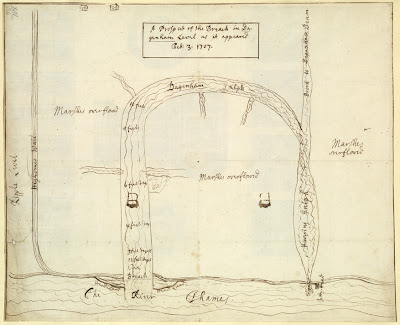 |
A Prospect of the Breach in Dagenham Level as it appeared Feb. 3 1707 |
us lastly enquire into the Manner how these Trees came
to be interred, which is a difficulty more easy to be re-
solved than the last. And this I take to be from the
gradual increase of the Mud, or Sediment, which every
Tide of the Thames left behind it. I presume those Trees
might be thrown down before the Walls or Banks were
made, that keep the Thames out of the Marshes; and
then those Trees were over-flown every Tide. And by
reason they lay thick, and near one another on the
ground, they would soon gather a great deal of the Se-
diment, and be soon covered therewith. And after the
Thames- Walls were made, every Breach in them, and
Inundation would leave great quantities of Sediment be-
hind it; as I by a troublesome Experiment found, in
going over some of the Marshes, soon after the late
preach, where I found the Mud, generally above my
Shoes,and in many places above my Knees. And it is
a practice among us (of which we have divers Instances)
that where a Breach would cost more to stop, than the
Lands over-flown will countervail, there to leave the
Lands to the mercy of the Thames; which by gradu-
ally growing higher and higher, by the Additions of
Sediment, will in time shut out the Water of the River,
all except the biggest Tides. And these Lands they call
Saltings, when covered with Grass; or else they become
Reed-ground &c.
From
(January 1, 1753) published in the
Philosophical Transactions of the Royal Society

No comments:
Post a Comment